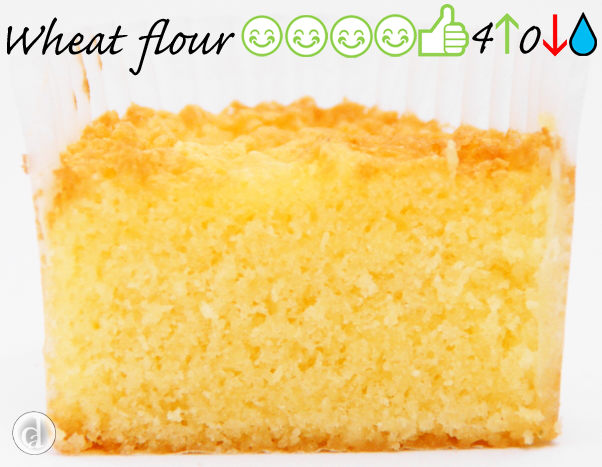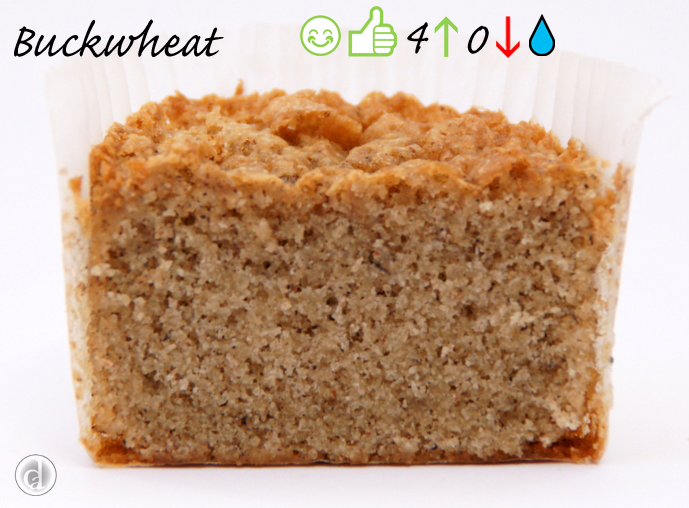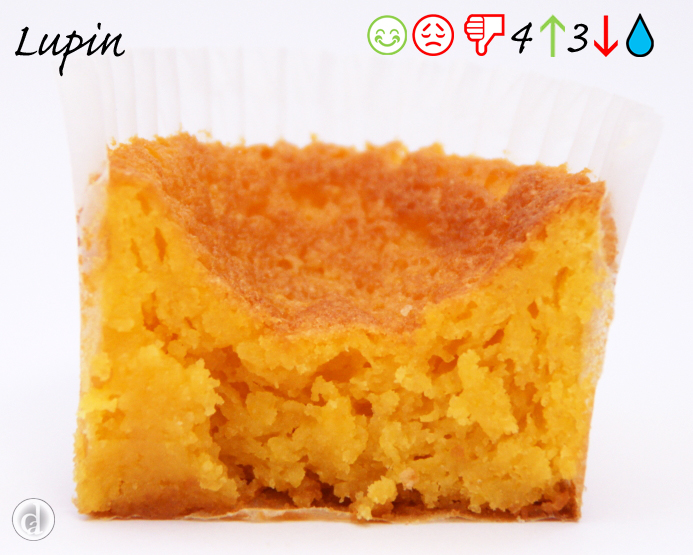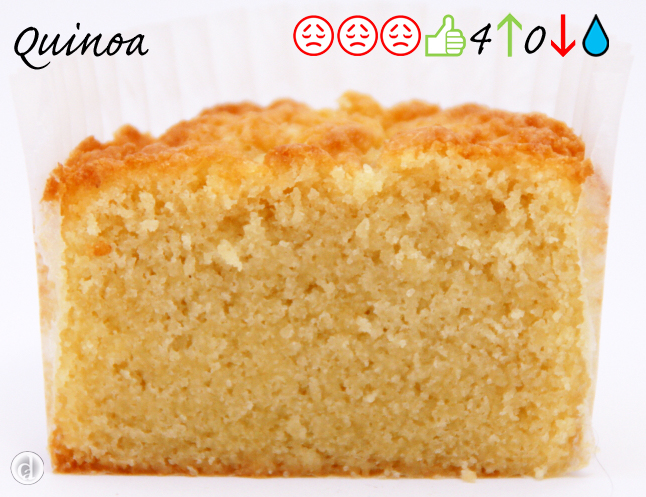Cup Cake Stress Test - Testing gluten free flours

I love all sorts of cakes. Well, let me rephrase that. I love cakes that are flavoursome (a good flavour), smell good, have a structure & a texture that is suitable for them and that they look good. Cakes that when you break a piece off a few crumbs will fall that you can save for later while you get the last smidgeon of icing with your fingertip. YUM! That’s what I would like to be able to do to a cake made with gluten free flour and I am sure you do to.
Baking a cake can be a fairly simple process for those on a wheat based diet particularly when it involves choosing an appropriate flour. Sometimes a flour is chosen purely on the consumers choice of flour brand but this decision is usually based on prior knowledge/recommendation (or cost). So what is the difference when it comes to baking a gluten free cake? For a start the sheer number of gluten free flour blends made by different companies is a little overwhelming. Then the actual ingredients in the gluten free flours can differ making it harder to choose between brands. Finally your choice may be narrowed down to 2 different brands but they vary in the amounts of the individual ingredients. How do you choose which one to use?
Growing up I was a curious child always asking my mum "Why?". Now I might be older with a few grey hairs & a much larger waistline but I still ask "Why?". Some of the questions that I wanted answered are. How do the different flours compare with wheat flour in terms of taste, smell and texture? Do they absorb water the same way? Can they be used to make a cake without the middle sinking? Do you cook them for the same length of time? Basically there is only one way to answer these questions – by using the individual flours in different recipes. For each of the available alternatives I have made cupcakes and then compared their products with ones made from wheat.
My cupcake stress test involves making the cakes using a butter cake recipe that is close to sinking in the middle when made with wheat flour (recipe ratio below). It is so easy to see which ones fail the “Can I make a cake out of this flour?” test. Unfortunately a photo will not allow you to taste the product. It is all very well if you can bake a cake that doesn’t sink in the middle but what if it tastes so awful you can’t eat it. That is why I have also included the YUM INDEX, an indication of taste. My children helped a great deal when it came to tasting the products, so if you see ![]()
![]()
![]() they only had to chew it once before spitting it out (Their comments were “Mum that was skull and crossbones!”). Of course taste is subjective and you may need to try it for yourself!
they only had to chew it once before spitting it out (Their comments were “Mum that was skull and crossbones!”). Of course taste is subjective and you may need to try it for yourself!
On the photos of each of the cupcakes I have indicated how they scored for taste ![]() , texture
, texture ![]() (or
(or ![]() or
or ![]() ), structure
), structure ![]()
![]() and moisture
and moisture ![]() or
or ![]() The YUM INDEX is an indication of the taste of the final product. The best is
The YUM INDEX is an indication of the taste of the final product. The best is ![]()
![]()
![]()
![]()
![]() while the worst is
while the worst is ![]()
![]()
![]() . Flours that were assigned with the worst taste indicator would not be suitable for making a sweet cake solely with that flour. It would need to be diluted with other better flavoured ingredients. Cupcakes that were borderline in taste will have
. Flours that were assigned with the worst taste indicator would not be suitable for making a sweet cake solely with that flour. It would need to be diluted with other better flavoured ingredients. Cupcakes that were borderline in taste will have ![]()
![]() and would also benefit with the addition of better flavoured ingredients. The texture of the cupcakes should be slightly crumbly with the appearance of small separate balls
and would also benefit with the addition of better flavoured ingredients. The texture of the cupcakes should be slightly crumbly with the appearance of small separate balls![]() . A
. A![]() indicates that these weren’t present while some cupcakes texture was okay
indicates that these weren’t present while some cupcakes texture was okay ![]() . The structure of the cake refers to its ability to rise during baking and stay there while cooling. The cupcakes that had the best structure were assigned 5
. The structure of the cake refers to its ability to rise during baking and stay there while cooling. The cupcakes that had the best structure were assigned 5![]() while ones that did not rise at all were given 1
while ones that did not rise at all were given 1![]() . A down arrow
. A down arrow ![]() indicates how much the cake sunk while cooling. The rest of the cupcakes ranged between these two. Cupcakes that were dry are indicated by
indicates how much the cake sunk while cooling. The rest of the cupcakes ranged between these two. Cupcakes that were dry are indicated by ![]() while ones that were moist are indicated by
while ones that were moist are indicated by ![]() .
.
Cupcake stress test recipe ratio
1x Butter
1.6x Sugar
0.8x Egg
1x Milk
1.2x Flour (or starch)
For comparison I have included photos of cupcakes made with wheat flour & wheat starch.


The Gluten Free Cupcakes





























What information can we get from the above to help us make gluten free cakes?
Structure of the cake: We know the gluten free flours that under the stress test can make cakes (with no added gums) that have a good structure and texture. Some are better than others in the height of the cake.
Teff
Quinoa
Buckwheat
Chestnut
Maize
Besan
Good taste: We know the gluten free flours that have an acceptable taste (according to my children).
Teff
Cocoa
Coconut
Maize
Millet
Chestnut
Buckwheat
Brown Rice
White Rice
White Sorghum
Okay taste: We know the gluten free flours that have an okay taste (according to my children). This group needs to be diluted with other more flavoursome ingredients.
Besan
Carob
Garbanzo & Fava (this is a mix of Besan & Fava)
Golden Flaxseed
Red Lentil
Lupin
Black Rice
Glutinous Rice
Red Sorghum
Bad taste: We know the gluten free flours that have an awful taste (once again, according to my children).
Amaranth
Blackbean
Moong
Quinoa
Soy
Gritty: Some of the flours were gritty & the resulting cakes were a little "sandy". This will be dependent on the source of the flour (how it was milled).
Millet
Black Rice
Brown Rice
Glutinous Rice
White Rice
Maize
Protein content
The protein content & protein type of a flour is extremely important for baking cakes. In the absence (or tiny amounts) of protein the structure of the cupcakes is altered significantly. Included in the photos above are cupcakes made with starches from wheat, maize, potato & tapioca (& they look unappealing). The amount of protein present in a flour is usually present on the nutrition panel on the package. It is however more difficult to obtain the types of protein present in the different flours. In reality what we need to know is whether the protein present in the flour helps or hinders the baking process.
The amount of protein in Wheat flour (all purpose) will vary from season to season but is usually 9 - 10 g/100g (9% - 10%).
How do the gluten free flours compare with wheat flour in terms of their protein content? The following protein contents were obtained from product information or using the FSANZ website. The flours that can be used to make cupcakes that don't sink (a lot) are in blue. The flours that produce cupcakes with the greatest height (then may collapse) are in green.
Low Protein - the flour has a lower protein content than wheat
Carob - 4.6g/100g
Chestnut - 5.2g/100g
Maize - 8.1g/100g
Rice - 6 - 7g/100g The protein content of rice varies with type.
Mid Protein - the flour has a similar protein content to wheat
Amaranth -14g/100g
Buckwheat - 13.2g/100g
Coconut - 14g/100g
Millet - 11g/100g
Quinoa - 11.9g/100g
Sorghum - 10.4g/100g
Teff - 13.3g/100g
High Protein - this group has a protein content more than 2x that of wheat flour.
Besan - 22.4g/100g
Blackbean - 23g/100g
Cocoa - 19 - 25g/100g The protein content of Cocoa varies greatly depending on the manufacturer.
Garbanzo & fava - 20g/100g
Red Lentil - 25g/100g
Moong - 23.8g/100g
Very High Protein - this group has a protein content greater than 30g/100g or 30%.
Golden Flaxseed - 37g/100g
Lupin - 39g/100g
Soy - 34.5g/100g
The majority of flours that can make a cupcake in the cupcake stress test similar to a wheat cupcake (on looks) have a protein percentage similar to wheat. The majority of flours that give the greatest height to the cupcakes have a protein percentage greater than 20%. Of course there are exceptions to both of these groups.
There is no doubt that protein is needed for the structure of the cupcakes. But how much protein is needed & what protein? It is easier to determine the amount of protein needed than the type of protein. We know that a flour containing ~5% protein (chestnut flour) can be used to make the cupcakes. We also know that flours containing ~8 - 14% protein can make the cupcakes. However some flours that contain this amount of protein produce cupcakes that do not rise a great deal (maize, millet, rice, sorghum).
Basically a gluten free flour with a protein content of 5 - 14% has the potential to make a cake, it will however depend on the type of protein present in the flour. For more information on protein and cakes read the article Cakes - The power of protein.
